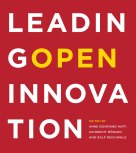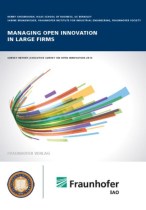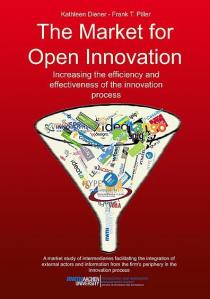Following the wake of the previous post, you can find below a selection of 2013’s relevant Open Innovation reports.
1. Open Innovation Market Study, 2013 Edition
 This RWTH-TIM’s open innovation study explores the market of open innovation accelerators (OIA); organizations that help their clients to include external experts in all stages of an innovation project.
This RWTH-TIM’s open innovation study explores the market of open innovation accelerators (OIA); organizations that help their clients to include external experts in all stages of an innovation project.
Open innovation today has become a core tool in innovation management. But which is the right method for open innovation? Which are the criteria to plan an open innovation project? Which intermediary or service provider has specific knowledge and expertise in, e.g., crowdsourcing, the lead user method, netnography, idea contests, technology scouting, or broadcast search? This totally updated 2013 edition report provides a comprehensive analysis of the providers and platforms for open innovation.
We take a detailed look on the methods, cost, project and community structures, and market size. Our purpose is to support strategic decisions when planning an open innovation venture. Managers will gain an overview of the intermediaries available for open innovation and will get advice how to identify partners for their project.
We invited more than 160 intermediaries to join our survey investigating the OIA’s business model and environment, productivity, services offered, project specifics, and characteristics of their participant pool. In addition, we asked about estimates for the development of the open innovation market. Besides a lot of highly interesting findings about the market for open innovation in general and the intermediary’s role in it, we were also able to compile 188 detailed accelerator profiles.
Futher info about this report can be found at:
- Key Results – Global Market for Open Innovation Support
- Market for Open Innovation Services to Top $6bn in 2014
- Ideation contests dominate the Market for Open Innovation
- Who purchases Open Innovation services? Non-profits and public agencies are coming up
- Who Participates in Open Innovation: A Solver and Community Perspective on the Market for Open Innovation
2. Leading Open innovation >> New edited MIT book on co-creation and open innovation
 In today’s competitive globalized market, firms are increasingly reaching beyond conventional internal methods of research and development to use ideas developed through processes of open innovation (OI). Organizations including Siemens, Nokia, Wikipedia, Hyve, and Innosabi may launch elaborate OI initiatives, actively seeking partners to help them innovate in specific areas. Individuals affiliated by common interests rather than institutional ties use OI to develop new products, services, and solutions to meet unmet needs.
In today’s competitive globalized market, firms are increasingly reaching beyond conventional internal methods of research and development to use ideas developed through processes of open innovation (OI). Organizations including Siemens, Nokia, Wikipedia, Hyve, and Innosabi may launch elaborate OI initiatives, actively seeking partners to help them innovate in specific areas. Individuals affiliated by common interests rather than institutional ties use OI to develop new products, services, and solutions to meet unmet needs.
Leading Open Innovation describes the ways that OI expands the space for innovation, describing a range of OI practices, participants, and trends. The contributors come from practice and academe, and reflect international, cross-sector, and transdisciplinary perspectives. They report on a variety of OI initiatives, offer theoretical frameworks, and consider new arenas for OI from manufacturing to education.
3. Berkeley-Fraunhofer Study on Open Innovation
 Our collegues of Fraunhofer IAO and University of Berkeley (Henry Chesbrough and Sabine Brunswicker) have surveyed large firms in the US and in Europe about whether or not they actually practice open innovation. The results are very interesting. Here are some key findings:
Our collegues of Fraunhofer IAO and University of Berkeley (Henry Chesbrough and Sabine Brunswicker) have surveyed large firms in the US and in Europe about whether or not they actually practice open innovation. The results are very interesting. Here are some key findings:
- Among companies with sales larger than $250 million annually, 78% practice open innovation
- Among those companies, 71% report that top management support for these activities are growing
- 82% of firms report that open innovation is more actively practiced now, compared to three years ago
- None of the companies in the survey have abandoned open innovation as of now.
As another evidence of the relevance of the Open Innovation concept worldwide, you can just see the last fall issue of the MIT Sloan Management Review >> Special Report on Leveraging External Innovation.
Finally, all those interested in these topics would really enjoy the meetings we are preparing for our next World Conference on Mass Customization, Personalization, and Co-Creation [MCPC 2014] at Aalborg University. See you there!
Frank Piller (RWTH/MIT)








